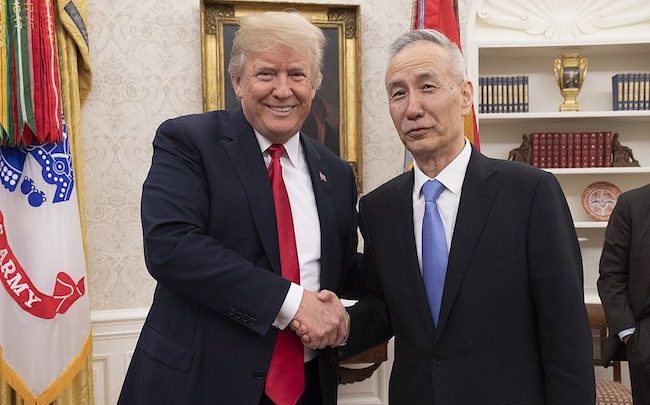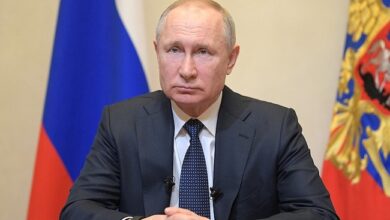
As the present world order weakens, the mega confrontations have appeared more likely: On its post-Soviet revival quest, Russia becomes increasingly assertive in Euro-MED theatre and beyond. The Sino-American relations are increasingly adversarial, with escalating frictions over trade, advanced technology, human rights, and global strategic influence.
Currently, both sides – as president of the US Council of Foreign Relations Richard Haass states – ‘are developing scenarios for a possible war’. The two countries rhetoric has grown so hostile that its speed and severity is unprecedented for the post WWII period, rather belonging to the forgotten vocabulary of 1910s and 1930s. (E.g. referring to PRC as ‘Country of Kung Flu’ or to the US as ‘trigger happy nation’; calling the C-19 ‘China virus’ or ‘US Army brought pathogen’; China’s Foreign Ministry Spokesman referring to the US leadership as ‘Elements deluded by the Capitol Hill metastasis’ while the US State Secretary calls the Chinese Communist Party ‘rogue actor’, and then in return Secretary Pompeo gets proclaimed as ‘the public enemy of mankind’ – just to name but few from the long list of heavy verbal fire exchanges between the two.)
Strategic decoupling between the biggest manufacturer of American goods – China, and its largest consumer – the US, seems inevitable.
It also appears increasingly irreversible, no matter if the change of leaders in Beijing or in Washington may or may not happen beyond 2020. This will of course trigger a global realignment and new fragilities to all default lines on land and seas, in skies, cyberspace and near outer space.
White House and House of Cards
Of course, many would reject the above as an overstatement and author’s alarmism. To this end, let us state some facts:
- Extensive exchange of goods is not deterrent. Trade is an instrument of power not a virtue per se, even though be it the RCEP or TPP. (The case of the UK and Germany in the eve of the WWI, and of Japan and the US in 1941, are the most known, in the series of such examples starting with the Peloponnese, Trojan and Punic wars, through the Napoleonic wars and Continental blockade all the way up to modern times, when nations were ‘sleepwalking’ strait into a major mutually devastating and lasting armed conflict.);
- Absence of (regional) nuclear parity deterrent. (Asia hosts by far the largest number of nuclear powers – 2 legitimate, 3 declared, 1 undeclared and at least 2 states with the credible delivery systems and N-ready ‘turn-key’ technology. None of them is even by its quantities, qualities, configurations and delivery capabilities – which makes the First strike doctrine tempting.)
- Diminishing international order due to a combination or either of the following:
a) Successful challenger to the Status Quo power/s. Or when a Dismissive meets a Neuralgic one. (Such constellation makes both sides nervous: Challenger is eager to contend and change, and the Status Quo power tempts to strike sooner as it feels the time does not contribute to its strength – with a compromise as a biggest looser. The modern-day China is portrayed as once-upon-a-time Imperial Germany – an illiberal opaque power that misuses liberal system on its unchecked quest for a world domination. Collision course is fanned irrespectively from a fact that there are no overlapping territorial claims or even common borders, as well as despite an unprecedented interconnectivity and mutually brought prosperity. Confrontation is not only geo-economic but also ideological: Liberal world of freedom against illiberal order of coercion.);
b) Weakening political support of the main guarantors to the existing International Regime, due to their contracting economics and/or demographics (Simply, Trump, Johnston, Bolsonaro, Modi, Kaczyński, Orbán are not causes to but the consequences of fading politico-economic system of the western type of democracy);
c) Absence of the comprehensive regional system to temporarily uphold or replace the shrinking global one (while Europe is the most multilateralised region on our planet, Asia is the only world’s continent that has no single, even less the security related, pan-continental organisation).
Although the new US President is in place, it would be foolish to expect any policy reversal. The new administration will see China the same way: Not as a dangerous (trade) rival, but as a foe.
Is this yet another author’s alarmism?
Biden presidency will be one of the weakest in the past 100 years. It is indeed a Pyrus victory: Trump got few million votes more now than in 2016 (i); Senate is controlled by Republicans (ii); angry Trump electorate is deeply convinced that the victory has been stolen from them, and will be further galvanising enlarging noising and tilting to the right for the following 4 years (iii); the blue-collar America firmly believes China steals their jobs – and none on the Democratic left even attempted to refute that (iv). Hence, Biden’s four years in office (if) will be marked by alienation from those electing him, and by pure agony of cohabitation with stifling Republicans. Administration will remain paralysed (if even willing) for any reversed yet fresh policy formulation.
Finally, history of the US bipartisanism teaches us that traditionally Democrats were opening wars while Republicans were those closing them. Overstatement? Mind, also that for nearly past 150 years, Trump presidency was the only 4-year period Americans did not start a single war. Many now believe, it is a high time to recuperate and compensate.
Ergo, a change in the White House – paradoxically enough – will not slow down the ongoing strategic decoupling and to it compulsory global re-alignment. On contrary, it will only accelerate its speed and severity.
To be sure; only a measurable success in the US-led de-Chinasation of the West will determine how far (and how long) will take the ongoing de-globalization, and if the second phase will be a reversibility, a re-globalization of the world. There is no other way to convert growing nationalistic passions into internationalist drives.
History of Future – Inevitability …
It was expected that by the end of 2020s, Asian economies will be larger than the rest of world’s economies combined. Africa-Middle East were to come up next. Of course, that was only a prediction made before C-19 and the sudden Sino-American rift. Or this was the origin of that rift? – It is still to be seen.
Past the demise of global communism, many in Asia, Africa and Middle East enjoyed for decades, the best of both worlds: Cheep products from China and the military protection – or at least an implicit security guaranty – from the US, nearly for free.[1] This especially goes for the southeast Asia (formerly representing the major Asian default line), large sways of south Afro-Asia and of the Far East.
The imposed re-alignment will hit them particularly hard – from a prosperous meeting point of goods, cultures and ideas into the politico-military default lines. This painful readjustment may last for decades to come. Opting for either side will not only impact economy trade and security but will also determine a health of population and societal model, too. Unprepared and unwilling for either-or – particularly Asia – missed to build, what I called for for over a decade; a comprehensive cross-continental security setting (the pan-Asian OSCE).
The inland giga-demography, inward looking culture, obedient imitator, humble manufacturer en mas – overnight presses globally and over the sea lanes: From diligent labourer to the omnipresent global power. In the grand rapprochement of 1970s, the coastal areas of China have been identified by the West as its own industrial suburbia. And now, that ‘industrial zone’ has a coherent planetary plan.
Was the Deng’s China joining the system to preserve it, or to tacitly hijack it from within? The shockwaves swept all in the West. The US – after its initial hangover – undergoes a painful adjustment: There is a growing consensus among all stakeholders in Washington that the strategic engagement is a failed policy with Beijing – something that obviously did not preserve the US interests, even less its supremacy. Chine is not a dangerous (trade) rival, it is a foe.
This will now seek for the binary acclamation all over the rest of our world. Time of ‘either-with-us-or-against-us’ returns, while the Middle East – North Africa (MENA) and Afro-Asia have no their third way readily prepared to offer (for at home and abroad) but only alignment behind one or the other – reminiscence of the pre WWI Europe with the two rigid (and soon conflagrating) blocks.
Beyond the Sino-world, the rest of Asia, Africa and Middle East (ME) are also dominated by mega demographies, brewing social mobilisations, expectations and migrations, inward looking regressive political culture (often lacking the world-view perspectives and contributions), insecure Asian nuclear powers, and history of rather hierarchical international conduct and architecture, than of a multivectoral vibrant active foreign policy (a bandwagoning instead of multilateralism).
All this necessitates to revisit the fundamentals of the African Union (AU), Organisation of Islamic Cooperation (OIC), League of Arab States (LAS) and other similar mechanisms: But it even more invites to rethink and reinvigorate the best of the Non-Aligned Movement (NAM) which saved the world from the past irresponsibilities and frictions of the two confronted blocks that contested each other all over the globe for decades.
Case of the EU – AU’s (or ASEAN’s) twin sister – is an indicative: At present, the EU is destructive in MENA, dismissive with Russia, neuralgic on Turkey and post-Yugoslav space, obedient to China and submissive to the US. None of it serves interests of Europe on a long run.
However, realities are plain to see: the ME seeks for consolidation, Russia for cooperation, China for domination and the US for isolation. Judging the (in-)action of the current Commission, seems the EU does not grasp it well. Therefore, losses its appeal, and tomorrow it may its substance as well, with overall BRAINXIT. Desirably, the AU (or ASEAN) should learn from the Twin’s, not from its own, mistakes:
The Indo-Pacific, ‘The Quad’, initiative (from Horn of Africa to East Pacific coast) is not a viable policy response for the age of global realignment. It is rather a panicking tactics of imperial retreat (seen in the past with the ‘Coalitions of the Willing’). Why to side it up in lieu of the long-term principles shouldering the skilfully calibrated strategic and emancipatory orientation?
MENA and Afro-Asia should not exhaust its entire foreign policy intellectualism on that. A host of historic south-south summit of 1956 (RI), champion of true multilateralism, along with numerous founding members of NAM should not peripheries themselves by becoming a default, Maginot Line but should lead a reinvigorated Third way.
Between confrontation and bandwagoning, it is time for a true multilateralism (active and peaceful coexistence postulated by the NAM). The Movement gave for so many and for so long a security shelter, voice above weight, sense of civilisational purpose, and a promising future of attainable prospect on the planetary quest for a self-realisation of mankind.
Confrontation is what you get, and cooperation is what you are fighting for.
[1] To this day, the US has concluded the security guaranty accord with some 70 countries on all continents of the world.




